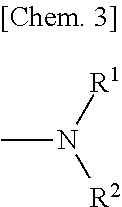Resin composition and use thereof
a technology of composition and resin, applied in the field of resin composition, can solve the problems of elastic modulus or poor dimensional stability, and achieve the effects of good appearance, excellent tensile strength and impact resistance, and easy availability in the mark
- Summary
- Abstract
- Description
- Claims
- Application Information
AI Technical Summary
Benefits of technology
Problems solved by technology
Method used
Image
Examples
synthetic example 1
Metallocene Catalyst
(1) Preparation of 1-tert-butyl-3-methylcyclopentadiene
[0199]In a nitrogen atmosphere, dried diethyl ether (350 ml) was added to a tert-butylmagnesium chloride / diethyl ether solution (450 ml, 0.90 mol, a 2.0 mol / l solution). A solution of 3-methylcyclopentenone (43.7 g, 0.45 mmol) in dried diethyl ether (150 ml) was added dropwise to the solution while keeping the temperature at 0° C. by ice cooling. The mixture was stirred at room temperature for 15 hours. To the reaction solution, a solution of ammonium chloride (80.0 g, 1.50 mol) in water (350 ml) was added dropwise while keeping the temperature at 0° C. with ice cooling. Water (2500 ml) was added to the resultant solution, and the mixture was stirred. The organic phase was separated and washed with water. Thereafter, a 10% aqueous hydrochloric acid solution (82 ml) was added to the organic phase while the temperature was kept at 0° C. with ice cooling. The mixture was stirred at room temperature for 6 hours. ...
production example 1
Preparation of Propylene / 1-butene Copolymer (Polymer 1) with Metallocene Catalyst
[0207]A 2000 ml polymerizer that had been thoroughly purged with nitrogen was charged with 875 ml of dried hexane, 75 g of 1-butene and 1.0 mmol of triisobutylaluminum at normal temperature. The temperature inside the polymerizer was increased to 65° C., and the polymerizer was pressurized to 0.7 MPa with propylene. Subsequently, there was added to the polymerizer a toluene solution in which 0.002 mmol of metallocene catalyst dimethylmethylene (3-tert-butyl-5-methylcyclopentadienyl)fluorenylzirconium dichloride from Synthetic Example 2 and 0.6 mmol in terms of aluminum of methylaluminoxane (manufactured by Tosoh Finechem Corporation) were in contact with each other. Polymerization was carried out for 30 minutes while keeping the internal temperature of the polymerizer at 65° C. and the propylene pressure at 0.7 MPa, and was terminated by the addition of 20 ml of methanol. The polymerizer was depressuriz...
production example 2
Preparation of Propylene / 1-butene Copolymer (Polymer 2) with Metallocene Catalyst
[0209]A 2000 ml polymerizer that had been thoroughly purged with nitrogen was charged with 875 ml of dried hexane, 75 g of 1-butene and 1.0 mmol of triisobutylaluminum at normal temperature. The temperature inside the polymerizer was increased to 60° C., and the polymerizer was pressurized to 0.7 MPa with propylene. Subsequently, there was added to the polymerizer a toluene solution in which 0.002 mmol of metallocene catalyst dimethylmethylene (3-tert-butyl-5-methylcyclopentadienyl)fluorenylzirconium dichloride from Synthetic Example 2 and 0.6 mmol in terms of aluminum of methylaluminoxane (manufactured by Tosoh Finechem Corporation) were in contact with each other. Polymerization was carried out for 30 minutes while keeping the internal temperature of the polymerizer at 65° C. and the propylene pressure at 0.7 MPa, and was terminated by the addition of 20 ml of methanol. The polymerizer was depressuriz...
PUM
| Property | Measurement | Unit |
|---|---|---|
| Tm | aaaaa | aaaaa |
| Tm | aaaaa | aaaaa |
| mol % | aaaaa | aaaaa |
Abstract
Description
Claims
Application Information
 Login to View More
Login to View More - Generate Ideas
- Intellectual Property
- Life Sciences
- Materials
- Tech Scout
- Unparalleled Data Quality
- Higher Quality Content
- 60% Fewer Hallucinations
Browse by: Latest US Patents, China's latest patents, Technical Efficacy Thesaurus, Application Domain, Technology Topic, Popular Technical Reports.
© 2025 PatSnap. All rights reserved.Legal|Privacy policy|Modern Slavery Act Transparency Statement|Sitemap|About US| Contact US: help@patsnap.com



